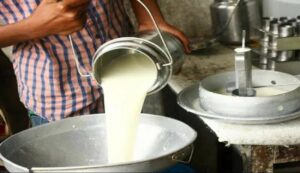Gujarat’s position as a leader in the dairy industry has been strengthened, with a turnover of so many crores
With more than 3.6 million farmer-members spread among 18,164 village cooperatives, Gujarat’s dairy industry, which is overseen by the Gujarat Cooperative Milk Marketing Federation (GCMMF), is still expanding at an amazing rate.

According to an official statement, the state’s dairy network maintains its position as a leader in India’s dairy sector by processing an incredible 215 million liters of milk per day.
The sector’s impressive yearly revenue of Rs 80,000 crore in the fiscal year 2023–2024 demonstrated both its strong growth and the effectiveness of its cooperative model.
Gujarat’s milk output, which has been rising at a Compound Annual rise Rate (CAGR) of 4.96 percent, above the national average of 4.57 percent, serves as more evidence of the rise.
This expansion highlights Gujarat’s leadership in the dairy industry in India and its role in milk production, which benefits millions of farmers and boosts the state’s economy.
The chairman of Banas Dairy, Shankar Chaudhary, stated: “Amit Shah was given responsibility for the establishment of a special ministry for cooperatives after the election of Modi ji as the nation’s prime minister in 2014. Cooperatives were promoted as a national model because they allow small individuals to band together and work together. The cooperative and Amul models, in my opinion, have not only worked well for the nation but also for the whole globe.
“As of right now, 35 lakh dairy farming families are making Rs 80,000 crore (96 billion USD),” he said. The Amul concept, technology, and transparency—all of which have been formalized by legislation—have enabled the amazing method in which funds are put into their accounts.
Gujarat’s milk output has been significantly influenced by the cooperative sector, which was established in 1942. When Narendra Modi became the state’s chief minister in 2001, the dairy industry saw a major uptick.
By building infrastructure, advancing technology, assisting women, promoting the Amul brand, and enacting laws that encouraged self-sufficiency and increased milk output, he fortified Gujarat’s dairy cooperatives.
Gujarat is a role model for milk production in the nation because so many of its farmers, particularly those with little or no acreage, are involved in dairy farming.
Local cooperative groups receive the milk deposits from these small dairy producers. The milk is then sent to a dairy for quality assurance. The milk is supplied to bigger factories only when its quality has been guaranteed.
Transparency and quality are the main goals of the whole process, guaranteeing that producers are paid fairly. The lives of people are being improved by Gujarat’s dairy industry’s advancements.
“The milk business is doing so well that even though there are no industries in our district, it has become the main source of livelihood along with farming,” said Faljibhai Patel, a dairy farmer in Ruppura village. We utilize this to run our homes, educate our kids, and take advantage of the many government programs that are put in place in the mandals. Additionally, union-sponsored projects like constructing homes and installing refrigeration units provide us with assistance.
“My name is Jayeshbhai Limbachiya, and we are from Ruppura village,” said Jayeshbhai Limbachiya, another dairy farmer. Our hamlet has an excellent milk dairy that receives milk contributions from the whole community. Milk makes a very big profit. Our major branch, Banas Dairy, is situated here, and we get a lot of assistance from the government. There are several plans that assist us. Even those without land are managing their livelihoods, operating milk businesses, and making significant profits.
Gujarat pioneered the cooperative dairy concept, which resulted in the founding of Amul, and so played a significant part in India’s White Revolution.
With its effective cooperative organization, technical innovations, and substantial contributions to the domestic and international milk supply, it is now regarded as a model for milk production.
The state is now India’s top milk producer because to its creative strategy.





